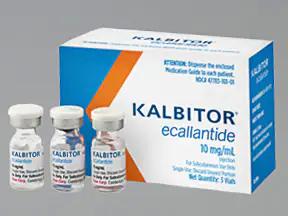Ecallantide Side Effects
Applies to ecallantide: subcutaneous solution.
Important warnings
This medicine can cause some serious health issues
Subcutaneous route (solution)
Anaphylaxis has been reported after administration of ecallantide.
Because of this risk, ecallantide should only be administered by a healthcare professional who is aware of the similarity of symptoms between anaphylaxis and hereditary angioedema and who has the appropriate medical support to manage both conditions.
Patients should be monitored closely.
Precautions
It is very important that your doctor check your or your child's progress closely to make sure that this medicine is working properly and to decide if you should continue to receive it.
This medicine may cause a serious type of allergic reaction called anaphylaxis. Anaphylaxis can be life-threatening and requires immediate medical attention. Tell your doctor or nurse right away if you have a cough, difficulty with swallowing, dizziness, a fast heartbeat, wheezing, shortness of breath, trouble breathing, chest tightness, swelling in your face, hands, tongue, or throat, a fever, chills, a runny nose or sneezing, itching or hives, or lightheadedness or faintness after you get the injection.
Common side effects of ecallantide
Some side effects of ecallantide may occur that usually do not need medical attention. These side effects may go away during treatment as your body adjusts to the medicine. Also, your health care professional may be able to tell you about ways to prevent or reduce some of these side effects.
Check with your health care professional if any of the following side effects continue or are bothersome or if you have any questions about them:
More common side effects
Less common side effects
- bleeding, blistering, burning, coldness, discoloration of the skin, feeling of pressure, hives, infection, inflammation, itching, lumps, numbness, pain, rash, redness, scarring, soreness, stinging, swelling, tenderness, tingling, ulceration, or warmth at the injection site
- muscle aches
- nausea
- sore throat
Serious side effects of ecallantide
Along with its needed effects, ecallantide may cause some unwanted effects. Although not all of these side effects may occur, if they do occur they may need medical attention.
Check with your doctor or nurse immediately if any of the following side effects occur while taking ecallantide:
Less common side effects
- blurred vision
- chest discomfort
- confusion
- cough
- difficulty with breathing
- difficulty with swallowing
- dizziness
- dizziness, faintness, or lightheadedness when getting up suddenly from a lying or sitting position
- fast heartbeat
- feeling of warmth
- fever
- hives or welts, itching, or skin rash
- puffiness or swelling of the eyelids or around the eyes, face, lips, or tongue
- redness of the face, neck, arms, and occasionally, upper chest
- redness of the skin
- runny nose
- sneezing
- stuffy nose
- sweating
- throat irritation
- tightness in the chest
- unusual tiredness or weakness
See also:
For healthcare professionals
Applies to ecallantide: subcutaneous solution.
General adverse events
The most common adverse reactions were headache, nausea, diarrhea, pyrexia, injection site reactions, and nasopharyngitis.[Ref]
Dermatologic
Gastrointestinal
- Very common (10% or more): Nausea (up to 13%), diarrhea (up to 11%)
- Common (1% to 10%): Vomiting, upper abdominal pain[Ref]
Hypersensitivity
- Common (1% to 10%): Anaphylaxis
- Frequency not reported: Hypersensitivity reactions[Ref]
Local
- Common (1% to 10%): Injection site reactions[Ref]
Nervous system
- Very common (10% or more): Headache (up to 16%)[Ref]
Other
Respiratory
- Common (1% to 10%): Upper respiratory tract infection, nasopharyngitis[Ref]
References
1. (2009) "Product Information. Kalbitor (ecallantide)." Dyax Corporation
Frequently asked questions
More about ecallantide
- Compare alternatives
- Reviews (2)
- Dosage information
- During pregnancy
- Drug class: hereditary angioedema agents
- Breastfeeding
- En español
Patient resources
Other brands
Professional resources
Other brands
Related treatment guides
Further information
Ecallantide side effects can vary depending on the individual. Always consult your healthcare provider to ensure the information displayed on this page applies to your personal circumstances.
Note: Medication side effects may be underreported. If you are experiencing side effects that are not listed, submit a report to the FDA by following this guide.

